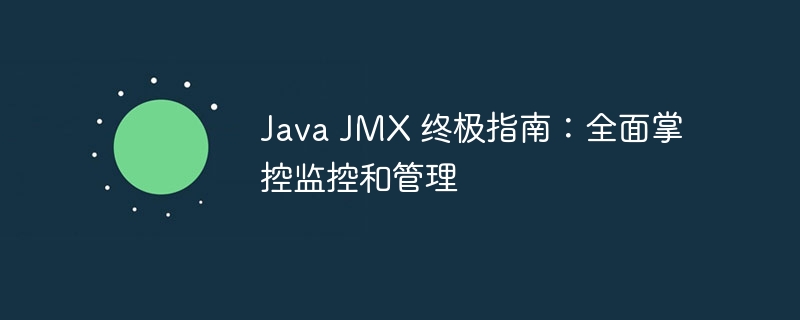Home >Java >javaTutorial >The Ultimate Guide to Java JMX: Take Control of Monitoring and Management
The Ultimate Guide to Java JMX: Take Control of Monitoring and Management
- PHPzforward
- 2024-02-20 21:20:08976browse

The Ultimate Guide to Java JMX: Take Control of Monitoring and Management Java Management Extensions (JMX) is a management and monitoring standard for the Java platform, providing developers with rich tools and APIs to monitor and manage the runtime status of Java applications. This guide is carefully created by PHP editor Banana, covering the basic concepts, architecture, usage and actual case analysis of JMX, helping readers fully understand and master JMX technology, so as to manage and monitor their Java applications more effectively.
Java Management Extensions (JMX) is a key technology for monitoring and managing Java applications. It enables administrators to gain insight into the internal state of an application, identify issues and make informed decisions to optimize performance and reliability.
Base
JMX is based on a layered architecture, including the following components:
- Management Information Model (MBean): An entity that represents the state of a managed application.
- Management Information Base (MIB): A collection containing all registered MBeans.
- Management Agent (MAgent): Acts as an MBean repository and provides an interface for management operations.
- Java Manager (JConsole, VisualVM): Connect to MAgent and provide graphical management tools.
MBean Type
There are two main types of MBeans:
- Standard MBean (Standard MBean): Provides a flexible but complex way to create MBean.
- Dynamic MBean (Dynamic MBean): Simplifies MBean creation, but the functionality is limited.
MXBean
MXBean is a simplified MBean intended for use with management information defined in the platform specification. Compared with standard MBeans, MXBeans have the following advantages:
- Easy to create and use
- Conform to Java specification
- Performance optimization
Monitoring properties
MBean properties can expose the real-time state of the application. These properties can be readable, writable, or both. By monitoring these properties, administrators can track application health and performance.
operate
MBean operations allow administrators to perform operations to manage applications. These operations can include start, stop, configuration, or diagnostic tasks. When performing an operation, administrators can pass parameters to the MBean and receive responses.
notify
MBean notifications allow applications to publish events to administrators. These events can indicate application state changes, errors, or alerts. By subscribing to notifications, administrators can proactively monitor applications and respond quickly.
Case Demonstration:
The following code demonstrates how to create and manage a simple MBean:
import javax.management.*;
public class SimpleMBean {
private int count = 0;
public int getCount() {
return count;
}
public void incrementCount() {
count++;
}
public static void main(String[] args) throws Exception {
MBeanServer mbs = ManagementFactory.getPlatfORMMBeanServer();
ObjectName name = new ObjectName("com.example:type=SimpleMBean");
SimpleMBean mbean = new SimpleMBean();
mbs.reGISterMBean(mbean, name);
JConsole jconsole = JConsole.getInstance();
jconsole.connect(new MBeanServerConnectionFactory(mbs).createConnection(null));
}
}
After running this code, you can use JConsole to connect to the MBean and view its properties and operations.
application
JMX can be used in a wide variety of applications, including:
- Performance Monitoring: Track application resource consumption, response time and throughput.
- Configuration Management: Configure application settings remotely without restarting.
- Troubleshooting: Diagnose problems and identify errors and performance bottlenecks.
- Automated Management: Use scripts and tools to Automate management tasks.
Best Practices
In order to use JMX effectively, it is recommended to follow the following best practices:
- Use MBeans with caution: Only expose information that is critical for monitoring and management.
- Use the appropriate MBean type: Select the MBean type that matches your needs.
- Enable notifications: Actively monitor application status changes.
- Protect the MAgent: Restrict access to the MAgent to improve security .
Summarize
Java Management Extensions (JMX) is a powerful tool that provides comprehensive monitoring and management capabilities for Java applications. By understanding its foundation, components, and applications, you can effectively leverage JMX to optimize application performance, increase reliability, and simplify management tasks.
The above is the detailed content of The Ultimate Guide to Java JMX: Take Control of Monitoring and Management. For more information, please follow other related articles on the PHP Chinese website!

